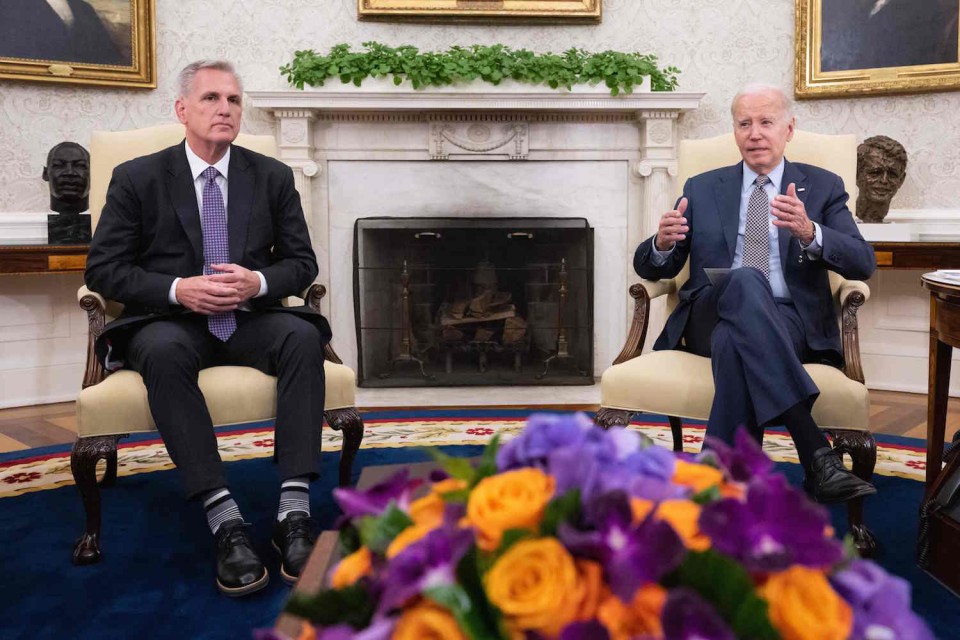
WASHINGTON, May 28, 2023 (AFP) – Top Republican leader Kevin McCarthy and President Joe Biden announced a deal Saturday to raise the debt ceiling, dragging the United States from the precipice of default with only a few days left to go.
Congress will vote on the deal to extend the government borrowing authority Wednesday, just shy of the June 5 “X-date” when the Treasury estimates the government will no longer be able to pay its bills, plunging the world’s biggest economy into turmoil.
“After weeks of negotiations we have come to an agreement in principle,” McCarthy, the speaker of the Republican-held House of Representatives, said.
McCarthy, who spoke with Biden on Saturday to close the deal, said he would consult again with the president Sunday and oversee final drafting of the bill. The House will “then be voting on it on Wednesday.”
Biden said in his own statement that the deal was “good news for the American people, because it prevents what could have been a catastrophic default and would have led to an economic recession, retirement accounts devastated, and millions of jobs lost.”
Despite the breakthrough, McCarthy cautioned there was “still a lot of work to do” in getting Congress to give its backing.
– ‘Compromise’ –
Raising the debt ceiling — a legal maneuver that takes place most years without drama — allows the government to keep borrowing money and remain solvent.
This year, Republicans demanded deep spending cuts — largely in social spending for the poor — in return for raising the debt ceiling, saying the time had come for bitter medicine to address the country’s mammoth $31 trillion debt.
Biden argued that he would not negotiate over spending issues as a condition for raising the debt ceiling, accusing the Republicans of taking the economy hostage.
Both sides have now somewhat climbed down.
According to US media reports, the outline of the deal includes freeing up the debt ceiling for two years, meaning there will be no need for negotiations in 2024, when the nation is in full presidential election swing.
The big spending cuts Republicans wanted are not there, according to reports, but effectively a budget freeze will take effect. There will also be tougher rules on accessing unemployment benefits and other federal assistance.
Biden said “the agreement represents a compromise, which means not everyone gets what they want. That’s the responsibility of governing.”
– Deadlines –
Treasury Secretary Janet Yellen had initially warned of a possible default around June 1 if Congress failed to raise the ceiling on borrowing, but gave lawmakers some breathing room on Friday when she updated the deadline to June 5.
Even so, the legislation will still have to clear Congress much more quickly than the normal timetable for even the most uncontroversial bills.
Under House rules, lawmakers have to be given 72 hours before voting once a bill is presented. And if it passes the House, it will then have to go through the Senate, where Democrats hold the majority.
McCarthy is hoping to bring the narrow House majority of 222 Republicans with him, but the deal is likely to face opposition from 35 far-right lawmakers who told him to “hold the line” against compromising on far more sweeping spending cuts. That means a large number of Democrats will have to be persuaded to vote with a reduced number of Republicans — something that rarely happens on big bills.
The Democrats may face their own rebellion on the left of the party, which objects to any spending restrictions.
Congress was adjourned for an extended holiday weekend but lawmakers will be called back to vote.
If a default occurs, the government wouldn’t miss loan repayments until mid-June but in the meantime it would likely have to halt $25 billion in social security checks and federal salaries.
The battle has been monitored closely by the major ratings agencies, with Morningstar and Fitch both warning that they could opt for a downgrade, even if crisis is averted.
When Barack Obama’s administration narrowly averted a default 12 years ago, a ratings downgrade cost taxpayers more than $1 billion in higher interest costs.







